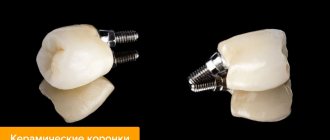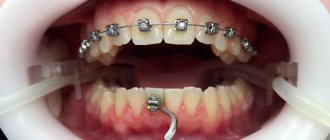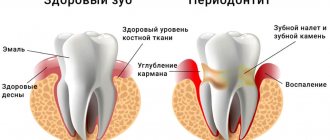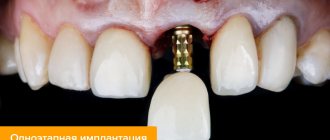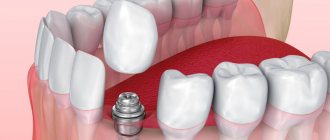A crown is the name in dentistry for a prosthesis that is placed on a tooth, on an implanted implant, or included in the structure of a dental bridge. With the help of dental crowns, you can restore severely damaged or lost teeth, the restoration of which must be carried out urgently and for this you must contact a dentist.
How the crown will be installed, whether it hurts to put a crown on a tooth - we will answer all these questions in detail in our article.
When is it necessary to put a crown on a tooth: indications for restoring teeth with a crown
The need to place a crown on a tooth may arise in the following situations:
- The tooth is severely damaged by caries. If the natural crown of a tooth is damaged by more than 50% by caries, then it would be more correct to put a crown on the tooth rather than restore it with a filling. Large fillings do not withstand the chewing load well and may fall out or break, and the tooth may break along with the filling. If the root of the tooth is damaged, then it will have to be removed. By placing a crown on a decayed tooth, you have the opportunity to save it;
- The tooth is destroyed as a result of trauma. If the roots of a tooth were not affected by injury, it is possible to restore the tooth - it will be enough to put a crown on it;
- You can also put a crown on a tooth for aesthetic restoration: for example, if a tooth is chipped or its enamel has changed color, becoming gray or yellow, and this defect cannot be eliminated by classic whitening.
Doctors recommend placing temporary crowns to preserve teeth for patients with periodontitis. In this case, crowns prevent teeth from becoming loose and falling out.
In your case, do you need to put a crown on your tooth or is it possible to use another restoration method? The doctors of our dental clinic in Moscow, “Firadent,” can help you find the answer to this question. To make an appointment with our specialists, you just need to dial our dental clinic’s phone number!
What is atraumatic tooth root removal?
What instruments does the surgeon use to achieve atraumaticity? For atraumatic removal, special instruments are used - thin, neat and elastic elevators that can minimally invasively penetrate and expand the periodontal tissue that connects the tooth root directly to the jaw. Using special instruments, the periodontal ligaments are cut so that the root can be removed as carefully as possible, in its “pure form.”
The vestibular plate that surrounds the bone is very thin. And we work with her carefully when removing teeth. It may also be necessary to saw the root of the tooth so that it can be removed in pieces. Sawing can be carried out with oscillating ultrasonic attachments - ultrasonic knives. Cutting the root of a tooth can be done quite effectively with a high-quality thin surgical dental bur, which has a certain length.
After cutting the root, the medial wall of the root is first removed, and then the vestibular wall of the root is removed. This allows for maximum preservation of surrounding tissue.
Then, after such removal, you can preserve the tooth socket or place an implant so that the bone is preserved as much as possible. Preservation of the tooth socket is carried out if there are no conditions for installing an implant at once, or if the patient undergoes delayed implantation.
If the roots of wisdom teeth are removed, the socket is not preserved; it is enough to remove them as atraumatically as possible. Let's talk about this in a little more detail.
Features of root removal of decayed wisdom teeth
Are there any difficulties when removing the roots of wisdom teeth? Removing the roots of wisdom teeth requires that the surgeon has sufficient experience. Often the roots of these third molars (wisdom teeth) are located close to the mandibular canal. Often the roots of molars are adjacent to the upper or lateral wall of the mandibular canal. The configuration of wisdom tooth roots is extremely diverse and sometimes extremely difficult to remove:
Therefore, when removing the roots of wisdom teeth, it is imperative that the patient undergo a CT scan. And the surgeon, as I said, needs to have some experience in surgical training in order to avoid the risks of removing the roots of such teeth and carry out the manipulation as efficiently as possible.
Like any root teeth, the roots of wisdom teeth are removed by cutting them along the roots. Wisdom teeth do not have problems because they are close to the angle of the lower jaw and there are strong cortical plates there. When I talked about thin vestibular walls, this comparison refers to the aesthetic zone of the smile, to the frontal group of teeth, including the premolars:
.
I need to put a crown on a tooth: is the treatment painful?
Statistics show that most people, knowing that they need to put a crown on a tooth, still postpone their treatment for fear of visiting the dentist and the pain that supposedly cannot be avoided with dental prosthetics. Does it really hurt to put a crown on a tooth? Let's look at this issue together.
So is it painful to put a crown on a tooth or not? The most painful stage in the process of installing a crown on a tooth will be the preparation, during which the teeth are treated for caries, depulped (if necessary), and also ground down to the thickness of the future crown. All these procedures are not performed without anesthesia, as they can cause quite severe pain to the person.
Before you begin to treat and prepare the tooth for placing a crown on it, the doctor will definitely perform an anesthesia procedure using a local anesthetic. The type and amount of the drug are selected individually for each patient. The use of anesthesia makes the process of preparing the tooth for crown installation painless.
If the patient experiences a literally panicky fear of dentists, in our dental clinic “Firadent” he may be offered dental treatment in his sleep[/anchor], under sedation. Sedation should not be confused with general anesthesia; it is a light medicated sleep in which the patient will remain during treatment. Sedation allows you to relieve the patient not only from pain when preparing teeth for prosthetics, but also from psychological discomfort and stress! Moreover, after sedation there are no negative side effects, which are not uncommon after general anesthesia.
You can read all the details on dental treatment during sleep in a separate article on our website, which is devoted to sedation, or find out during a consultation with the doctors of our clinic - “Firadent”.
How is tooth root removal done?
Are there any features or important points when removing a tooth root? Of course, any removal - be it tooth extraction, wisdom tooth removal, impacted tooth or tooth root should be carried out as atraumatically as possible, preserving the tissue structure
that surround a tooth or tooth root:
The goal of atraumatic root removal is to preserve bone
. Removal should be done painlessly.
The clinics of the German Implantology Center are supporters of atraumatic and painless removal. Our technologies have been proven over the years, and our patients feel very comfortable with them. It is no secret that many patients have fears about removal, and these fears sometimes postpone the surgical stage of treatment for a long time. In our clinics, we help patients overcome these fears. The patient may not be afraid of anything - both in the case of a single extraction and in case of multiple extractions of teeth
:
Initial examination and diagnosis
The decision that a crown needs to be placed on a tooth is made by an orthopedic dentist after examining the patient’s oral cavity and teeth, as well as performing a number of diagnostic measures. Based on the data obtained, the orthopedist will develop a treatment plan, which may include not only the installation procedure itself, but also a number of additional measures:
- Professional oral hygiene, which allows you to clean your teeth from plaque and tartar;
- Removal of severely damaged teeth that cannot be properly treated and restored with a filling;
- Treatment of caries and any other diseases of the teeth and gums diagnosed during examination;
- Tooth removal, treatment and filling of canals.
Note that depulping a tooth before placing a crown on it is not always done. The depulpation procedure involves removing the dental nerve, after which the tooth becomes more fragile and vulnerable to external factors. If a tooth has more than one root and is in good condition, doctors prefer not to remove the dental nerve and put a crown on a living tooth.
When drawing up a treatment plan, the question of what kind of crown will be placed on the tooth is also decided. Modern dental crowns are made from different materials and there is always the opportunity to choose the version of the prosthesis that will most suit the patient in terms of aesthetics, price and durability.
The drawn up treatment plan is agreed with the patient and after agreement the treatment process begins. The first step is to prepare the tooth for the installation of a crown.
Does it hurt to put it on?
Prosthetics is an uncomfortable and traumatic process. There is nothing terrible about it, but at certain stages painful sensations are possible:
- Preparation. If a living tooth needs to be treated for caries, pulpitis and other inflammatory processes, it is anesthetized. It is not necessary to administer anesthesia before endodontic treatment of dead units.
- Stitching and ledge formation. Vital teeth are prepared under anesthesia. Depulped ones are ground down to a living one, but because... Damage to the gums is possible; at the patient’s request, a superficial injection is given.
- Retraction. It is carried out during the formation of the ledge and before taking impressions. The placement of the thread is accompanied by a slight separation of the soft tissues from the tooth and the formation of gingival grooves. This is a painful procedure, so anesthesia is required.
- Taking impressions. It doesn't hurt, you only feel pressure on the jaw. But vital units can react sharply; in such cases, anesthesia is given. Nausea is also possible in patients with an increased gag reflex. Such patients are recommended to start taking mild sedatives – valerian, motherwort – a few days before going to the clinic. And immediately before applying the impression mass, the doctor sprays the root of the tongue with lidocaine spray.
- Cleaning the interdental areas from the remains of the impression mass. It is removed with dental floss and thin metal plates. During this, pressure and bursting are felt, and the gingival papillae may be injured. But overall the manipulation is tolerable.
- Fitting and fixation. They are painless and are accompanied by only slight pressure on the jaw.
Stages of prosthetics
In general, installing a crown on a tooth is more uncomfortable than painful. Report any sudden unpleasant sensations to the doctor - he will immediately administer anesthesia.
Preparing to install a dental crown
Preparing for a dental crown may include the following procedures:
- Professional teeth cleaning. Removing tartar and plaque from the surfaces of teeth will help you accurately select the color of the future crown, as well as identify primary caries and other diseases that are important to cure before placing a crown on the tooth.
- Treatment of caries, pulpitis, periodontitis, and gum inflammation. You can’t put a crown on sick teeth!
- Treatment of the tooth on which a crown will be placed. During this process, the doctor will drill out the tooth and remove all tissue affected by caries. If necessary, tooth depulpation is carried out, as well as treatment and filling of dental canals.
IMPORTANT: Dental canal treatment must be of high quality! If during the treatment of the canals the doctor makes a mistake, does not remove all the tissues affected by inflammation, or fills the canals incorrectly, the tooth may begin to hurt already under the crown, and then it will have to be removed and treated again! In our dental clinic “Firadent” in Moscow, treatment of tooth canals is carried out under a microscope with an optical device, which allows the doctor not to act at random, but to accurately see the length and internal space of the dental canals, and therefore carry out the procedure with impeccable quality.
After filling the canals, the tooth is restored with a filling and the next stage in prosthetics begins - turning the tooth under a crown.
Installation of the stump tab
Before prosthetics with stump inlays, it is necessary to remove the nerve and carry out endodontic treatment of the canals in order to eliminate their inflammation and seal them properly. After this, the tooth is prepared for an inlay, the canals are unfilled to 1/3 or 2/3 of their length, they are made wider and given a conical shape, and then procedures typical for the direct or indirect method of manufacturing a microprosthesis are carried out.
Stages of installing the stump tab
- All teeth are disinfected with alcohol and dried.
- The stump tab is degreased and covered with cement along with the pins.
- The holes in the channels are filled with a solution, and a microprosthesis is installed in them.
- For final fixation of the stump tab, the doctor applies strong pressure on it.
After this, all that remains is to take impressions from the stump insert installed in the tooth to make a crown from the material chosen by the patient.
Grinding a tooth for a crown
Before placing a crown on a tooth, the tooth must be ground to the thickness of the future prosthesis. This procedure in professional dentistry is called “preparation”. The enamel of the tooth is ground down with a drill and during the treatment the doctor will give the tooth a shape that will allow the crown to be placed firmly and tightly.
IMPORTANT: Grinding of live teeth can be quite painful, so local anesthesia must be administered before performing this procedure. If the tooth was depulped before grinding, local anesthesia may not be used, the procedure will not cause pain.
When preparing teeth, a layer of tissue is removed from the tooth before placing a crown. The thickness of the layer will depend on how thick the crown will be. A minimal layer of tissue is removed from the teeth for cast crowns; a significant layer of tissue must be removed from the tooth if it is decided to install ceramic or metal-ceramic crowns. On average, during the grinding process, about 2.5 mm of tissue is removed from a tooth on each side.
As a result of tooth preparation, a core base (stump) is obtained, on which the doctor will place a crown.
Is implantation possible after tooth root removal?
Yes, of course it is possible. And we at the clinics of the German Implantology Center widely use implantation after tooth root removal. Our conditions allow us to carry out implantation in such cases. And if we can achieve primary stability of the implant, then in 90% of cases
After removal, we immediately install the implant. We have rolled out the technology to perfection and gives excellent results.
Of course, with the exception of wisdom teeth, no implant is placed after their removal. But, by the way, wisdom teeth in this situation can be extremely useful, since they... can be transplanted to the place of the problem tooth being removed! Dental transplantation has been practiced in the clinics of the German Implantology Center since 2017, and our specialists have accumulated a wealth of clinical experience. Let's talk about this a little more.
Making crowns
Crowns are made from an impression that is taken from the prepared teeth. To obtain this impression, the orthodontist will use a special plastic mass. Based on the impression taken, the laboratory will first make a plaster model of the prosthesis, and then a crown, which will be placed on the tooth.
Modern dental crowns are made from different materials: metal, ceramic, metal-ceramic and zirconium. The timing of the production of the prosthesis will depend on what kind of crown it is decided to place on the tooth. Crowns made of ceramics and metal-ceramics take the longest to produce. So that a person does not have to walk without a tooth during the entire time of making the crowns, a temporary plastic prosthesis is put on the tooth.
IMPORTANT: Temporary plastic crowns help hide a defect in the dentition; a person will not have to be embarrassed by the absence of a tooth and experience stress for this reason. Also, temporary dentures help protect a ground and therefore weakened tooth from the negative effects of environmental factors and bacteria.
Try-on, temporary and permanent fixation of the crown
Before placing a crown on a tooth, it must be tried on. For this purpose, the patient is invited to the clinic. During the fitting, the accuracy of the crown's manufacturing and the tightness of its fit on the stump base are assessed. If the fitting does not reveal manufacturing inaccuracies, the patient does not feel discomfort and is satisfied with the aesthetics of the finished product - a temporary fixation of the crown is performed on the tooth.
What is temporary fixation? This is a kind of “test drive” of the crown. With a crown placed on a temporary basis, the patient will walk for a certain period of time (usually up to 4 weeks). If during this time no defects or inaccuracies are identified in the manufacture of the crowns, the patient comes to the clinic and the crown is placed and fixed with permanent dental cement.
At this point, the crown installation process can be considered complete.
How to place a crown on an implant?
A crown can be placed not only on a tooth, but also on an implant. This allows you to restore lost teeth without grinding down healthy units in the rows. Crowns on implants are durable, aesthetic, and visually indistinguishable from natural teeth.
Before placing a crown on an implant, an artificial root implantation procedure is performed. As soon as the implant takes root, an abutment is placed on it, and then a crown. Putting a crown on an implant will be more expensive than conventional prosthetics, but the price of the service is fully compensated by the impeccable aesthetics and long service life of both the implant and the crown.
Crown service life
Patients who plan to get a crown are often interested in its useful lifespan. The service life of a crown placed on a tooth will depend on a number of factors:
- Crown material and technology;
- The patient’s compliance with all doctor’s recommendations for crown care;
- Quality of preparation of teeth for prosthetics.
The last factor is of fundamental importance: if mistakes are made during the preparation and manufacturing of the crown, the crown will not last long, and undesirable complications may arise, due to which the crown will have to be removed and re-installed on the tooth. For these reasons, you need to very carefully choose the clinic where you plan to treat and restore your teeth! Remember that the worst type of saving is saving on your own health!
The crown must be placed in a well-equipped dental clinic, staffed by experienced orthopedic doctors and dental technicians. The clinic must use the most modern technologies for diagnostics, treatment and dental prosthetics; only this approach to the choice of dentistry guarantees high quality treatment!
How much does it cost to put a crown on a tooth?
How much does it cost to put a crown on a tooth? It is difficult to give a definite and precise answer to this question, because the cost of installing a crown may include various additional but necessary procedures. For example, professional teeth cleaning, treatment of caries or pulpitis, treatment and filling of canals.
The cost of installing a crown will be influenced by both the material and the production technology of the prosthesis. The most expensive options are ceramic and zirconium crowns produced using CAD/CAM technology. But such crowns fully pay for their cost due to their high strength, reliability and aesthetics.
Also, the cost of installing a crown will depend on how it will be placed - on an abutment tooth or on an implant.
The best way to find out how much it costs to put a crown on a tooth is to come to an appointment with orthopedic doctors at our dental clinic in Moscow - “Firadent”. Experienced specialists of our dentistry will conduct an examination and diagnosis and draw up a treatment plan, which will indicate the exact price of the service.


